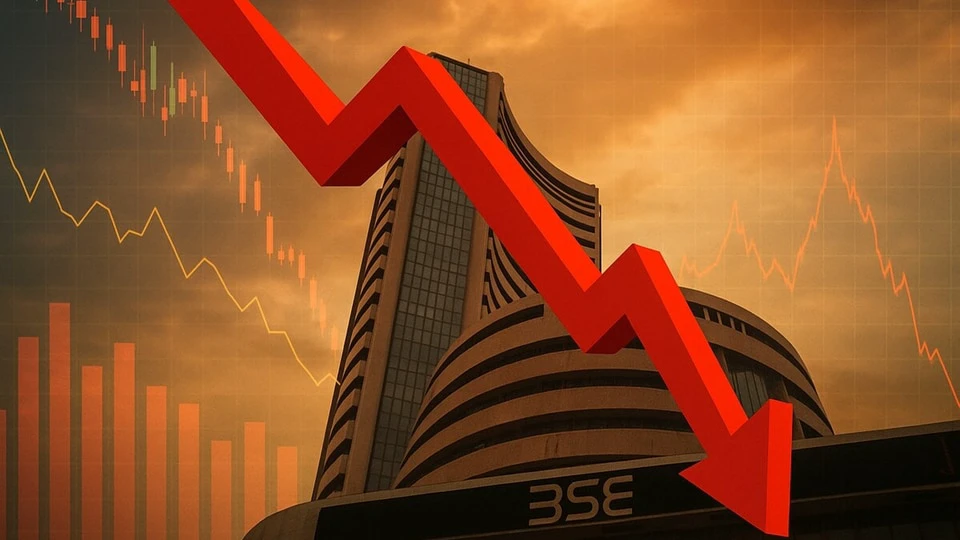After hitting record highs last year, the Nifty has slipped by around 6 percent over the past twelve months. The Sensex and Nifty hit their record highs of 85,978.25 and 26,277.35 touched on September 27, 2024.
While India’s long-term growth story remains intact, a series of global and domestic challenges have weighed on investor sentiment. Experts say the correction should be seen more as a reset than a structural reversal, but multiple headwinds have combined to drag markets lower.
Here are sone key reasons behind the 6% fall in the Nifty
Trade Tensions and Sentiment Shock: According to Anirudh Garg, Partner and Fund Manager at INVasset PMS, the sharpest trigger came from India-US trade relations. “The current 5% correction is best read as a sentiment-led shakeout rather than a structural reversal,” he said. Uncertainties around tariffs and negative headlines created jitters, particularly in export-linked sectors like IT and pharma. The friction with the US has not only raised fears of slower trade growth but also injected a risk premium into Indian equities.
FPI Outflows and Currency Weakness: Trivesh D, COO at Tradejini, pointed out that foreign flows have turned adverse. “India has seen significant FPI outflows (approx. $10-15 billion in 2025 so far), while the rupee has weakened beyond ₹88/USD,” he noted. The twin pressure of selling by overseas investors and a sliding currency amplified volatility. Along with tariff disputes, global crude price swings and rising US yields forced investors to unwind crowded positions. IT and financials bore the brunt of the selling, while defensives like pharma and bullion offered relative safety.
Earnings Disappointments: Muted corporate earnings have also kept the market under pressure. Devarsh Vakil, Head of Prime Research at HDFC Securities, said, “Corporate earnings have been lacklustre with Nifty-50 companies delivering only 8% growth, below market expectations.” High input costs and sluggish urban demand recovery weighed on margins, hurting overall investor confidence. This has reinforced caution among foreign investors, who have shifted portfolios toward cheaper emerging markets with stronger earnings momentum.
Valuation Concerns: Vakil further flagged valuations as another challenge. Indian equities remain expensive compared to peers, with the MSCI India Index trading at a CY26E P/E of 20x versus 12.4x for MSCI Emerging Markets. “That reflects a 65% premium, which remains above the long-term average of 49%,” he explained. Though the premium has moderated from the 85% peak in December 2024, it continues to limit foreign appetite, especially when coupled with policy uncertainty.
Geopolitical and Policy Risks: Geopolitics has added another layer of volatility. Vakil noted that “geopolitical concerns with neighbours and trade tensions with the U.S., due to tariffs on select Indian goods and stalled trade negotiations, have created policy uncertainty.” These developments, alongside tariffs on Indian exports and visa restrictions, have forced global funds to reprice risk, keeping Indian valuations under pressure.
US Policy Shocks and Sector Impact: Mayank Jain, Market Analyst at Share.Market, pointed out that US policy changes were a key factor behind the correction. “A major concern came from the United States, which imposed new tariffs on Indian pharmaceutical exports and tightened rules on H1B visas,” he said. These measures directly hit two of India’s flagship sectors-pharma and IT-raising fears of lower earnings growth and weaker export demand. The result was heavy foreign selling, coupled with further rupee weakness.
Outlook Ahead
Despite the 6 percent decline, most fund managers see this correction as a healthy reset rather than the start of a deeper downturn. Garg noted that “with sentiment adjusting and valuations cooling, the present drawdown looks more like a reset before the market can build the foundation for the next leg higher.” While challenges around trade, earnings, and global volatility remain, the downside is seen as capped, with the market using this phase to consolidate before aiming for new highs.
